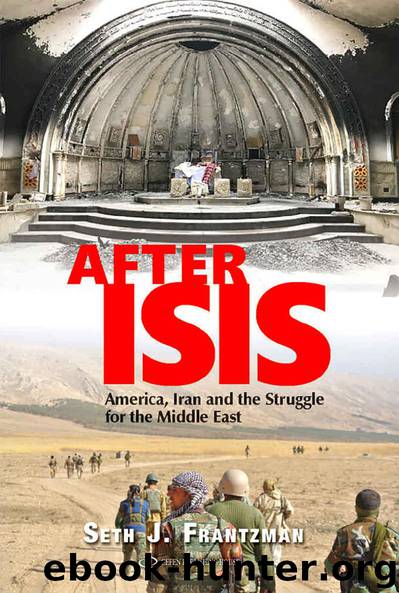After Isis:: America, Iran and the Struggle for the Middle East by Seth J. Frantzman

Author:Seth J. Frantzman [Frantzman , Seth J.]
Language: eng
Format: epub, azw3
Publisher: Gefen Publishing House
Published: 2019-09-02T22:00:00+00:00
Chapter 17
The Hot Summer of 2017
Washington and the Post-ISIS Vacuum
The Iraqi security forces carried out the battle for Mosul slowly and methodically. The optimism of early 2017 gave way to drudgery. The soldiers I saw in Mosul from the Federal Police and the Emergency Response Division were confident of victory, but they also felt no prodding to move faster.
As spring turned to summer, the war against ISIS lost priority in Washington. Donald Trump made an ostentatious visit to Saudi Arabia for an Arab Islamic American Summit on May 21. He mentioned ISIS six times in his speech. “Many are already making significant contributions to regional security: Jordanian pilots are crucial partners against ISIS in Syria and Iraq. Saudi Arabia and a regional coalition have taken strong action against Houthi militants in Yemen. The Lebanese army is hunting ISIS operatives who try to infiltrate their territory.”143 He argued for cutting off the financial support for ISIS, stopping it from selling oil and eradicating it in Syria. He also mentioned it in a list of other terror organizations: “the true toll of ISIS, al Qaeda, Hezbollah, Hamas, and so many others, must be counted not only in the number of dead. It must also be counted in generations of vanished dreams.” He contrasted these groups with the Middle East’s rich and natural beauty, vibrant cultures and “massive amounts of historic treasures.” In a sense the speechwriters were seeking to draw a line after ISIS was defeated and shine a light on a post-ISIS Middle East.
But the war wasn’t over. A week after Trump’s speech, the PMU reached the Syrian border. It liberated ISIS-held former Yazidi villages such as Tal Qasab and Tal Banat, sites of ISIS crimes in 2014. KRG president Barzani warned the PMU not to approach Sinjar, but the militias kept moving anyway, sweeping ISIS before them. On May 29, militia leaders posted photos of themselves on the Syrian border, and Hadi al-Amiri appeared on Al-Sumaria television. IRGC Quds Force commander Qassem Soleimani also came to the Syrian border.
Abadi came to Mosul at the end of May to “oversee liberation operations.” PMU leader Abu-Mahdi al-Muhandis met the prime minister, and they posted photos together. Kurds were watching the growing power of the central government and the Shi’ite militias and wondering if this was a portent of things to come. One Kurdish commander told Rudaw that if the Shi’ite militias commited any “transgressions,” they would “beat their heads against the mountains of Kurdistan.”144
After ISIS crossed into Iraq in 2014 and the US-led coalition began fighting the extremists in both Iraq and Syria, the conflict in the two countries became one large war. However, these wars were fought largely independently because of the way ISIS controlled most of the border. Each group fighting ISIS largely fought its own private war. In Iraq, that meant the Kurds and the Iraqi army and Shi’ite militias had fought separate campaigns up until the battle for Mosul. Once that battle began, the Kurdish role largely ceased, and the war on ISIS was led by the Iraqi security forces.
Download
After Isis:: America, Iran and the Struggle for the Middle East by Seth J. Frantzman.azw3
This site does not store any files on its server. We only index and link to content provided by other sites. Please contact the content providers to delete copyright contents if any and email us, we'll remove relevant links or contents immediately.
| Arms Control | Diplomacy |
| Security | Trades & Tariffs |
| Treaties | African |
| Asian | Australian & Oceanian |
| Canadian | Caribbean & Latin American |
| European | Middle Eastern |
| Russian & Former Soviet Union |
The Secret History by Donna Tartt(18157)
The Social Justice Warrior Handbook by Lisa De Pasquale(11951)
Thirteen Reasons Why by Jay Asher(8451)
This Is How You Lose Her by Junot Diaz(6434)
Weapons of Math Destruction by Cathy O'Neil(5829)
Zero to One by Peter Thiel(5488)
Beartown by Fredrik Backman(5351)
The Myth of the Strong Leader by Archie Brown(5237)
The Fire Next Time by James Baldwin(5016)
How Democracies Die by Steven Levitsky & Daniel Ziblatt(4952)
Promise Me, Dad by Joe Biden(4908)
Stone's Rules by Roger Stone(4855)
100 Deadly Skills by Clint Emerson(4689)
A Higher Loyalty: Truth, Lies, and Leadership by James Comey(4550)
Rise and Kill First by Ronen Bergman(4544)
Secrecy World by Jake Bernstein(4388)
The David Icke Guide to the Global Conspiracy (and how to end it) by David Icke(4378)
The Farm by Tom Rob Smith(4322)
The Doomsday Machine by Daniel Ellsberg(4245)
